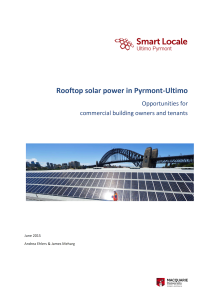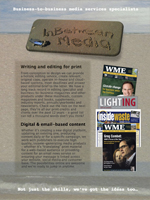A team of researchers has taken the first step in assessing feasibility for a number of buildings in the Pyrmont-Ultimo area of Sydney to install solar power.
In June, the Smart Locale Rooftop Solar Power project released the study, authored by Andrea Ehlers and James Meharg from Macquarie University. Overall, 22 commercial buildings were identified across the Pyrmont-Ultimo precinct, with potential capacity to install around 1,990 kW of solar systems, which could generate 2,465 MWh of renewable solar energy per year (equivalent to about 330 average homes). A database was developed for the identified properties including information on site evaluation and suitability, ownership and tenants.
Smart Locale believes the technology improvements that have enabled small-scale energy generation, manufacturing and shared services arrangements are spearheading a worldwide trend to act locally. The role of Smart Locale is to accelerate this transformation in the local precinct, reducing carbon emissions and saving money at the same time. This report is the first stage of the Rooftop Solar Power project being undertaken within Smart Locale.
While it’s true that commercial and institutional buildings, where energy use patterns align with the solar energy production hours, are often good targets for installing solar power systems, what are the benefits to building owners and tenants?
According to the report, in one case study on a ‘Building D’ in Ultimo, between 81-90% of generated power could be used on site with power consumption closely mirroring daylight hours. The feasibility assessment found that solar power installation would provide reductions in operating costs and that significant carbon reductions could be reported in the organisation’s sustainability credentials.
“The combination of declining technology costs and improving financing models structured to compliment solar power installation in commercial and institutional buildings is enabling sound returns on investment and positive cashflow for solar power installation,” said the report.
Motivating factors
Motivation for installing a solar power system sometimes comes from a major tenant who could find substantial cost savings with rooftop solar power generation with the right funding model.
There are six buildings identified in the study that meet the ideal physical criteria and have amenable ownership structures or a motivated tenant. Their collective usable roof space is approximately 4,500 square metres.
One of these sites was ‘Building D’, where the tenant expressed interest in progressing rooftop solar power installation for its growing creative technology development business. The tenancy comprises 2.5 floors of dense workstations, large open meeting areas and a large cafe-style eat/meet area.
The Sunulator tool was used to conduct an interim economic assessment of the selected site based on different system sizes and funding models, using generally accepted financial drivers. Sunulator is an open source economic feasibility tool for commercial solar power systems developed for the Alternative Technology Association.
The study identified that the building has 192 square metres of usable space, which equates to up to 25 kW of solar panels (potentially 29 kW using high efficiency panels).
The energy consumption for ‘Building D’ is around 67 MWh per year. Most of the power consumption is between 10am and 6pm, that is during daylight hours, including weekends.
Following analysis it was found that annual savings (energy costs avoided less financing costs) are the highest for the 25 kW system utilising a consumer loan or Environmental Upgrade Agreement (EUA), at $1,850 in the first year.
The highest 10 year Net Present Value (NPV) was from the 29 kW community owned system and 25 kW consumer loan/EUA system, at $19,211 and $19,085 respectively. NPV calculates the value of the rooftop solar system to the benefactor.
Given the usage patterns of the tenant, between 81-90% of generated power could be used on site. The total power exported to the grid increases as the system size increases, ranging from 10-19% export, the latter being at the end of tolerable metrics.
“As expected, the larger the system, the greater the energy cost savings and carbon reduction,” the report stated. However, with the low feed-in tariffs paid it is not necessarily optimum to go for the largest system. As direct purchase was not an option for the tenant, it was removed from the analysis.
In relation to a community owned model, the study did not investigate this in detail but noted that the outcomes of the current community funding offer for the 500 kW solar power system planned for the Sydney Convention Centre, will provide a valuable guide.
The next step for Smart Locale will be to further engage with building owners and tenants, especially the tenants of ‘Building D’ to see if they wish to progress to complete technical feasibility and identification of finance model.
If you are interested in finding out more about rooftop solar in Ultimo-Pyrmont, or may be interested in talking to someone at Smart Locale about the potential of your building, email info@smartlocale.com.au



Comments are closed.